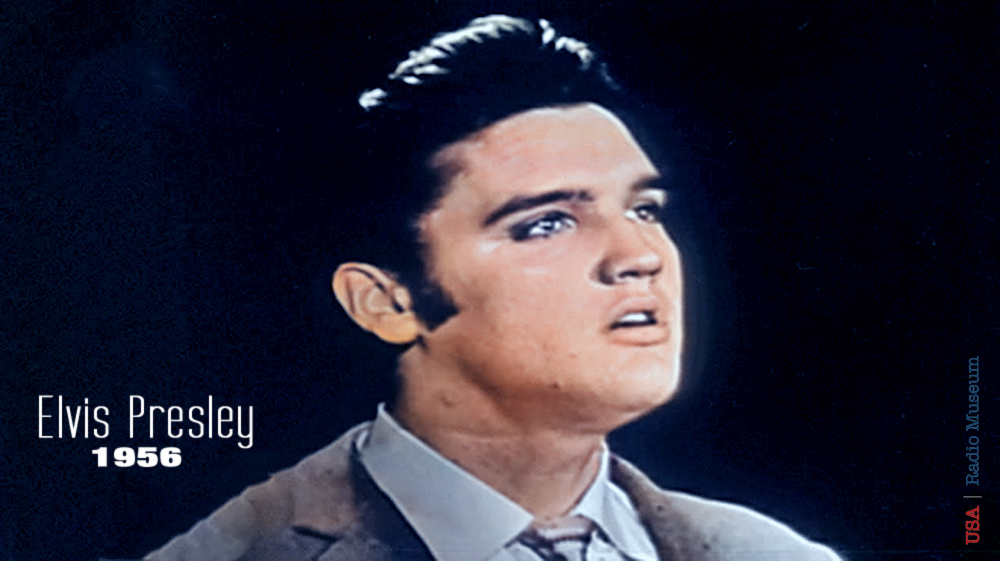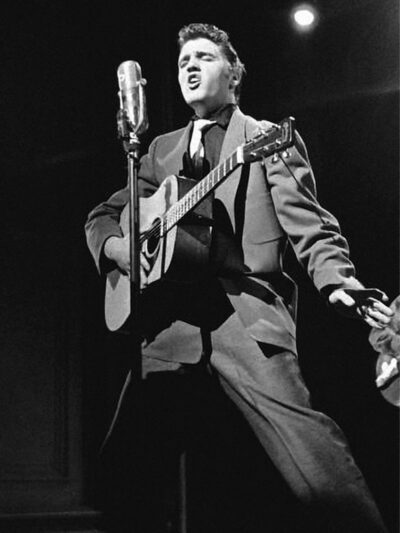Introduction: The Day Elvis Tendered Softness In Song to America There are moments in music history when a single note seems to change everything.
Introduction: The Day Elvis Tendered Softness In Song to America
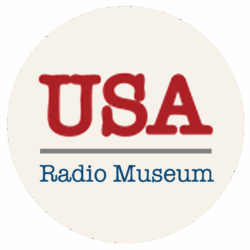 There are moments in music history when a single note seems to change everything. October 10, 1956 was one of those moments. On that day, Elvis Presley’s “Love Me Tender” entered the U.S. charts—not with a bang, but with a hush. It was a whisper that swept across the nation, softening hearts, shifting perceptions, and redefining the voice of a young man who had, until then, been known more for his hips than his heart.
There are moments in music history when a single note seems to change everything. October 10, 1956 was one of those moments. On that day, Elvis Presley’s “Love Me Tender” entered the U.S. charts—not with a bang, but with a hush. It was a whisper that swept across the nation, softening hearts, shifting perceptions, and redefining the voice of a young man who had, until then, been known more for his hips than his heart.
This wasn’t just a chart debut. It was a cultural pivot. A romantic ballad rooted in Civil War melody, sung by a 21-year-old who had already stirred controversy and captivated millions. “Love Me Tender” marked the moment when Elvis Presley became more than a rock-and-roll rebel. He became a voice of longing, a symbol of tenderness, and a bridge between generations.
For the USA Radio Museum, this moment is sacred. It represents the power of radio to not only broadcast sound, but to shape sentiment—to turn a song into a shared experience, a memory, a legacy. What follows is a deep dive into that day, that song, and the seismic shift it created in American culture. — USA RADIO MUSEUM
_____________________
The Context: 1956, A Year of Ascent
To grasp the cultural magnitude of October 10, 1956, we must rewind to the beginning of that year—a time when Elvis Presley was still a regional phenomenon, known mostly for his Sun Records sides and the raw electricity of his live performances. He was a Southern boy with a guitar and a growl, thrilling crowds in Louisiana and Tennessee, but not yet a national name.
That changed with breathtaking speed.
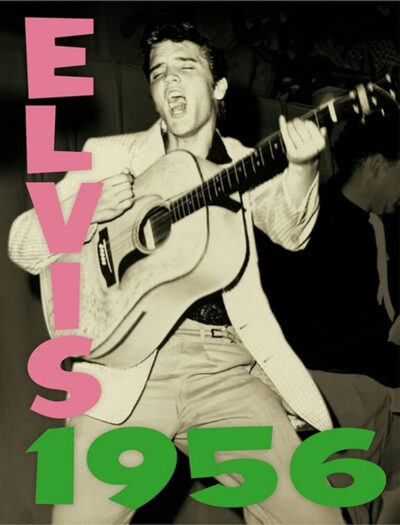 By the time autumn arrived, Elvis had become a household fixture. RCA Victor had signed him to a major contract and released two albums that shattered sales expectations, each moving over a million copies. His voice—equal parts swagger and vulnerability—was now echoing from coast to coast. Television, still a relatively new medium, embraced him with fervor. He appeared on national broadcasts eleven times in 1956 alone, captivating audiences on the Dorsey Brothers’ Stage Show, The Milton Berle Show, and most famously, The Ed Sullivan Show. Each appearance stirred controversy, admiration, and obsession in equal measure.
By the time autumn arrived, Elvis had become a household fixture. RCA Victor had signed him to a major contract and released two albums that shattered sales expectations, each moving over a million copies. His voice—equal parts swagger and vulnerability—was now echoing from coast to coast. Television, still a relatively new medium, embraced him with fervor. He appeared on national broadcasts eleven times in 1956 alone, captivating audiences on the Dorsey Brothers’ Stage Show, The Milton Berle Show, and most famously, The Ed Sullivan Show. Each appearance stirred controversy, admiration, and obsession in equal measure.
Hollywood took notice. That summer, Elvis inked a seven-year movie deal with Paramount Pictures, a bold move that signaled his transition from rock-and-roll rebel to multimedia star. His first film, Love Me Tender, was already in production and slated for a November release. It would be a Western, but the real draw was Elvis himself—his voice, his presence, his myth in the making.
Radio was the rocket fuel behind this ascent. DJs like Dewey Phillips in Memphis, Alan Freed in New York, and George Klein in Tennessee had championed Elvis from the start, spinning his records and defending his style against critics who dismissed him as vulgar or dangerous. By October, Elvis wasn’t just being played—he was being dissected, debated, and adored. His name lit up the airwaves. His songs sparked phone-in frenzies. His image, once confined to Southern juke joints, now loomed large in the national imagination.
In the span of ten months, Elvis Presley had gone from regional curiosity to cultural juggernaut. October 10 marked the moment when that momentum crystallized—when “Love Me Tender” entered the charts and confirmed what radio had already made clear: Elvis wasn’t just a singer. He was a phenomenon.
Radio’s Role: Amplifying the Myth
In the fall of 1956, radio wasn’t just a medium—it was a movement. It was the heartbeat of American culture, pulsing through car speakers, kitchen counters, and teenage bedrooms. And into that living, breathing network came Elvis Presley’s “Love Me Tender,” a song that didn’t just play—it lingered, haunted, and seduced.
Radio stations from Memphis to Manhattan embraced the track with fervor. WHBQ, WINS, KFWB—call letters that carried weight—began spinning it with near-religious regularity. DJs, once cautious about Presley’s provocative image, now found themselves swept up in the song’s gentleness. They introduced it not as a rock-and-roll riot, but as a romantic balm. Some crafted entire segments around it—“Elvis Hours,” “Tender Time,” “Dedication Nights”—where listeners could call in, share their stories, and request the song for someone they loved, missed, or hoped to win back.
The airwaves became a confessional. Teenagers phoned in with trembling voices. Mothers wrote letters thanking stations for playing something “beautiful.” Veterans heard echoes of wartime ballads in its melody. And Elvis, though far from the microphone, was suddenly everywhere—his voice a constant companion, his image reshaped by the very medium that had once branded him a menace.
Radio didn’t just broadcast “Love Me Tender.” It sanctified it. It turned a single into a shared experience, a national mood, a sonic embrace. And in doing so, it elevated Elvis from rebel to romantic, from controversy to comfort.
October 10, 1956: The Chart Debut
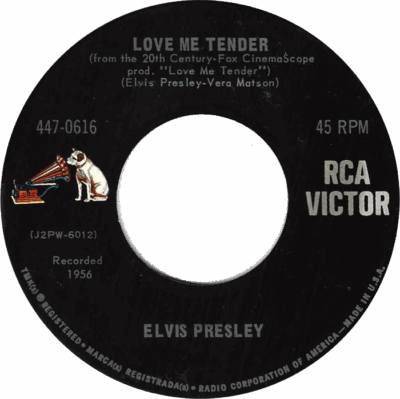 When “Love Me Tender” entered the U.S. music charts on October 10, 1956, it didn’t simply arrive—it erupted. The song’s debut felt less like a release and more like a cultural event, a moment when the airwaves themselves seemed to bend in reverence. Within days, it was climbing with astonishing velocity, propelled by a perfect storm of exposure, demand, and devotion.
When “Love Me Tender” entered the U.S. music charts on October 10, 1956, it didn’t simply arrive—it erupted. The song’s debut felt less like a release and more like a cultural event, a moment when the airwaves themselves seemed to bend in reverence. Within days, it was climbing with astonishing velocity, propelled by a perfect storm of exposure, demand, and devotion.
Across the country, AM radio stations gave the track heavy rotation, weaving it into morning shows, evening dedications, and late-night serenades. DJs who had once hesitated to embrace Elvis now leaned into the song’s softness, finding in its melody a bridge between controversy and comfort. Record stores struggled to keep up with the surge—fans lined up, shelves emptied, and distributors scrambled to meet the overwhelming demand.
Television added fuel to the fire. Elvis’s second appearance on The Ed Sullivan Show, scheduled for October 28, was already generating buzz, and “Love Me Tender” became the unofficial soundtrack to the anticipation. Viewers who had seen him perform the song weeks earlier were now hearing it daily, their excitement growing with each broadcast.
Radio DJs reported a level of listener engagement that bordered on feverish. Requests flooded in. Teenagers called with breathless urgency. Parents, once skeptical of Presley’s hip-shaking bravado, found themselves moved by the song’s tenderness. Its gentle tone softened resistance, while Elvis’s voice—still rich with sensuality—retained the magnetism that had made him a star.
“Love Me Tender” wasn’t just climbing the charts. It was climbing into hearts, into homes, into the cultural bloodstream of a nation in flux. October 10 marked the beginning of that ascent—a day when a ballad became a beacon, and Elvis Presley became something more than a singer. He became a voice of longing, of romance, of possibility.
Cultural Impact: From Rebel to Romantic
Before “Love Me Tender,” Elvis Presley was a lightning rod for controversy. His swiveling hips, sultry stare, and explosive stage presence had earned him the nickname “Elvis the Pelvis”—a moniker that carried both fascination and alarm. Parents fretted. Clergy condemned. Cultural critics dismissed him as a fleeting fad, a threat to decency wrapped in rhythm and blues.
But then came the ballad.
“Love Me Tender” changed everything. With its gentle melody and whispered vulnerability, the song revealed a side of Elvis that few had seen—a young man capable of tenderness, longing, and emotional depth. It wasn’t just a stylistic shift; it was a reintroduction. Suddenly, Elvis wasn’t just the rebel in a gold lamé suit—he was the romantic crooner, the voice of yearning, the boy who could sing to your soul.
This transformation rippled across the cultural landscape. Older listeners who had previously dismissed him began to lean in, drawn by the song’s sincerity. Women, already captivated by his charisma, now found themselves moved by his sensitivity. Even skeptics—those who had labeled him vulgar or shallow—began to reconsider. “Love Me Tender” gave Elvis legitimacy, not just as a performer, but as an artist.
Radio stations that had once banned his music now embraced him. The song’s success became a kind of proof—evidence that Elvis could transcend genre and expectation. DJs who had hesitated to play his earlier hits now spun “Love Me Tender” with pride, framing it as a turning point in his career and a balm for the cultural divide he had once ignited.
And in the entertainment industry, the impact was seismic. The success of “Love Me Tender” as both a song and a film theme inspired a wave of cross-media ambition. Artists and studios began to see the potential of multimedia stardom—of songs that could sell movies, and movies that could elevate songs. Elvis had shown the way, and others would follow.
In the end, “Love Me Tender” didn’t just soften Elvis’s image. It expanded it. It allowed him to be more than a provocateur. It made him a romantic icon, a cultural bridge, and a pioneer of the modern entertainment era.
Chart Longevity and Commercial Triumph: “Love Me Tender” Takes Hold
When “Love Me Tender” entered the Billboard charts in October 1956, it did so with a momentum rarely seen in pop music history. The single debuted amid a tidal wave of anticipation, having already received over one million advance orders before its official release—a feat that prompted Billboard to declare it a “guaranteed million seller” even before it hit shelves.
Once released, the song soared. It reached the #1 spot on the Billboard Top 100 chart and held that position for five consecutive weeks, beginning in late October and continuing through November 1956. Its reign was not fleeting—“Love Me Tender” remained on the charts for a total of 19 weeks, carrying over well into early 1957. The song’s emotional resonance and radio ubiquity ensured that it lingered long after its initial surge, becoming a staple of American airwaves and jukeboxes.
Sales figures reflected this fervor. RCA Victor, Elvis’s label, saw unprecedented demand. The single sold over one million copies within weeks, earning Gold certification and solidifying Elvis’s status as a commercial powerhouse. The accompanying EP, released in November 1956 and featuring four songs from the Love Me Tender film, also performed exceptionally well—peaking at #9 on the Top Pop Albums chart and selling over 600,000 copies.
“Love Me Tender” didn’t just dominate the pop charts—it crossed over into the R&B world as well. In 1956, the song reached #15 on the national R&B charts, a testament to its broad appeal and Elvis’s growing influence across musical genres. This crossover success was significant. It demonstrated that Elvis’s tender ballad could resonate beyond his core rock-and-roll audience, touching listeners across racial and stylistic boundaries during a time when such crossover was rare.
The song’s chart performance and sales figures weren’t just impressive—they were transformative. “Love Me Tender” proved that Elvis Presley was more than a flash in the pan. He was a force capable of reshaping the musical landscape, one tender note at a time.
_____________________
The “Love Me Tender” EP: A Soundtrack That Sang Its Way into History
While the single “Love Me Tender” soared to the top of the charts, its companion release—the Love Me Tender EP—carved out its own remarkable legacy. Released by RCA Victor on November 1, 1956, the extended-play record featured four songs from Elvis Presley’s debut film of the same name: “Love Me Tender,” “Let Me,” “Poor Boy,” and “We’re Gonna Move.” Though brief in runtime, the EP packed a cultural punch that echoed far beyond its nine-minute length.
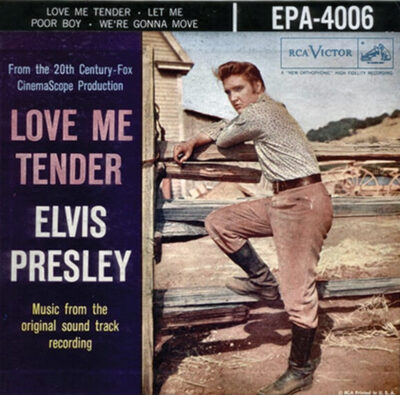 Rather than issuing a full-length LP, RCA opted for the EP format to align with the film’s release and capitalize on the single’s explosive popularity. The strategy worked. The Love Me Tender EP peaked at No. 9 on the Billboard Top Pop Albums chart and sold over 600,000 copies in its initial run. It also made an unusual crossover to the singles chart, reaching as high as No. 35—a rare feat for an EP at the time.
Rather than issuing a full-length LP, RCA opted for the EP format to align with the film’s release and capitalize on the single’s explosive popularity. The strategy worked. The Love Me Tender EP peaked at No. 9 on the Billboard Top Pop Albums chart and sold over 600,000 copies in its initial run. It also made an unusual crossover to the singles chart, reaching as high as No. 35—a rare feat for an EP at the time.
The EP’s success was further cemented decades later when it was simultaneously certified Gold and Platinum by the RIAA on March 27, 1992. In total, domestic sales eventually surpassed 1.25 million units, with worldwide sales reaching an estimated 2 million copies.
The recording sessions for the EP were held at 20th Century Fox’s Stage One in Hollywood, marking a departure from Elvis’s usual studio environment. For these tracks, he worked with a different set of musicians—including Vito Mumolo on guitar and The Ken Darby Trio on backing vocals—adding a cinematic warmth and polish to the sound. The result was a collection of songs that felt both intimate and expansive, perfectly suited to the film’s romantic Western setting.
The Love Me Tender EP wasn’t just a soundtrack—it was a statement. It marked the beginning of a new phase in Elvis’s career, one where music and film would intertwine, and where every note carried the weight of a growing legend. For RCA, it was a commercial triumph. For Elvis, it was a bridge between mediums. And for radio, it was another chapter in the story of how sound could shape sentiment, stardom, and history.
The Film Connection: When Sound Became Sight
By the time Love Me Tender premiered in November 1956, the song had already become a national obsession. But the film wasn’t just riding the wave—it was part of the storm. Originally titled The Reno Brothers, the movie was renamed to match the song’s success, a rare reversal that underscored just how powerful Elvis’s voice had become. This wasn’t just a soundtrack—it was the selling point.
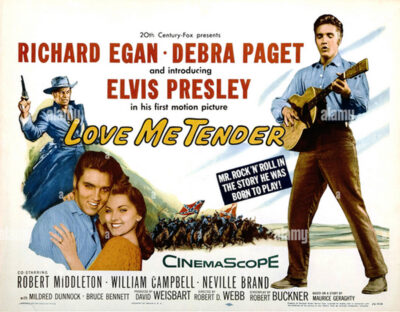 Elvis’s role as Clint Reno, a Confederate soldier caught in a web of loyalty and heartbreak, marked his first foray into Hollywood. Though the film was a modest Western, its emotional core was unmistakable. Elvis didn’t play a rock star—he played a brother, a husband, a man torn by love and loss. And audiences responded not just to the story, but to the sincerity he brought to the screen.
Elvis’s role as Clint Reno, a Confederate soldier caught in a web of loyalty and heartbreak, marked his first foray into Hollywood. Though the film was a modest Western, its emotional core was unmistakable. Elvis didn’t play a rock star—he played a brother, a husband, a man torn by love and loss. And audiences responded not just to the story, but to the sincerity he brought to the screen.
Radio stations treated the film’s release like a cultural event. DJs previewed the soundtrack, interviewed cast members, and hosted contests tied to the premiere. Some stations even staged “Love Me Tender” movie nights, where fans could win tickets or share dedications on air. The synergy between radio and cinema had never been stronger—each medium amplifying the other, each helping Elvis transcend the boundaries of genre and format.
In theaters, the response was electric. Fans lined up around the block. Some screamed. Some cried. Some fainted. Elvis’s presence on screen—brooding, vulnerable, magnetic—confirmed what radio had already suggested: he wasn’t just a voice. He was a phenomenon. And Love Me Tender was the proof.
Emotional Legacy: A Voice That Still Whispers
Nearly seven decades have passed since Elvis Presley first sang “Love Me Tender” into the hearts of a nation, yet its echo remains. The song endures not merely as a chart-topping hit or a cinematic theme—it endures as a feeling. A memory. A moment suspended in amber.
For many, it was the first slow dance. The first kiss. The first time a voice on the radio felt like it was speaking directly to them. “Love Me Tender” became more than a melody—it became a companion to life’s most intimate chapters. It played at weddings and anniversaries, at high school proms and quiet nights alone. It comforted soldiers overseas and soothed sweethearts back home. It was sung in living rooms, hummed in kitchens, and remembered in hospital rooms and funeral parlors. It was, and remains, a lullaby for the soul.
Elvis himself would go on to record dozens of hits, star in over 30 films, and become one of the most iconic figures in the history of popular music. But “Love Me Tender” holds a singular place in that legacy. It was the moment he revealed his heart. The moment he stepped beyond the stage and screen and into the emotional lives of millions.
For the USA Radio Museum, this song represents the power of broadcast to do more than entertain. It reminds us that radio is not just a delivery system—it’s a vessel for memory, for connection, for love. On October 10, 1956, when “Love Me Tender” first graced the charts, it wasn’t just a new entry. It was a new era.
And today, when that familiar guitar strum begins and Elvis’s voice floats through the static, we’re transported—not just to a different time, but to a different feeling. One of tenderness, of longing, of timeless devotion.
That’s the magic of radio. That’s the magic of Elvis.
Closing: Echoes That Still Embrace Us
As we reflect on October 10, 1956, we’re reminded that history isn’t always loud. Sometimes, it’s quiet. Sometimes, it’s tender. Elvis Presley’s chart debut with “Love Me Tender” was one such moment—a gentle revolution that unfolded not in riots or headlines, but in the soft crackle of a radio speaker and the hush of a nation leaning in to listen.
The song’s legacy lives on—not just in vinyl grooves or digital playlists, but in the emotional architecture of American memory. It taught us that vulnerability could be powerful, that romance could be rebellious, and that a voice could carry more than melody—it could carry meaning.
For curators, broadcasters, and fans alike, “Love Me Tender” remains a touchstone. It reminds us why we preserve sound, why we honor voices, and why radio matters. It’s not just about what we hear—it’s about what we feel. And on that October day, Elvis made us feel something unforgettable.
So let the record play. Let the memory linger. Let the love and tenderness echo ever so softly . . . today, as though Elvis Presley, and the year 1956, were all over again.
_____________________
Contact: jimf.usaradiomuseum@gmail.com
_____________________
A USARM Viewing Tip: On your PC? Mouse/click over each image for expanded views. On your mobile or tablet device? Finger-tap all the above images inside the post and stretch image across your device’s screen for LARGEST digitized view. Then click your brower’s back arrow to return to the featured post.
© 2025 USA Radio Museum. All rights reserved.

